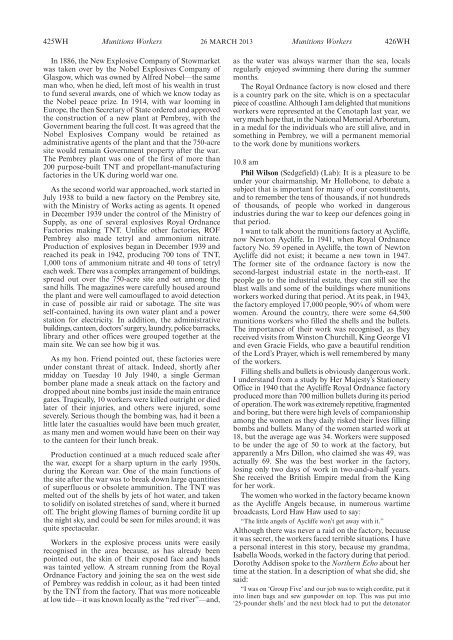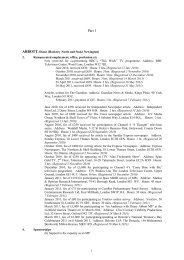PARLIAMENTARY DEBATES - United Kingdom Parliament
PARLIAMENTARY DEBATES - United Kingdom Parliament
PARLIAMENTARY DEBATES - United Kingdom Parliament
Create successful ePaper yourself
Turn your PDF publications into a flip-book with our unique Google optimized e-Paper software.
425WH<br />
Munitions Workers<br />
26 MARCH 2013<br />
Munitions Workers<br />
426WH<br />
In 1886, the New Explosive Company of Stowmarket<br />
was taken over by the Nobel Explosives Company of<br />
Glasgow, which was owned by Alfred Nobel—the same<br />
man who, when he died, left most of his wealth in trust<br />
to fund several awards, one of which we know today as<br />
the Nobel peace prize. In 1914, with war looming in<br />
Europe, the then Secretary of State ordered and approved<br />
the construction of a new plant at Pembrey, with the<br />
Government bearing the full cost. It was agreed that the<br />
Nobel Explosives Company would be retained as<br />
administrative agents of the plant and that the 750-acre<br />
site would remain Government property after the war.<br />
The Pembrey plant was one of the first of more than<br />
200 purpose-built TNT and propellant-manufacturing<br />
factories in the UK during world war one.<br />
As the second world war approached, work started in<br />
July 1938 to build a new factory on the Pembrey site,<br />
with the Ministry of Works acting as agents. It opened<br />
in December 1939 under the control of the Ministry of<br />
Supply, as one of several explosives Royal Ordnance<br />
Factories making TNT. Unlike other factories, ROF<br />
Pembrey also made tetryl and ammonium nitrate.<br />
Production of explosives began in December 1939 and<br />
reached its peak in 1942, producing 700 tons of TNT,<br />
1,000 tons of ammonium nitrate and 40 tons of tetryl<br />
each week. There was a complex arrangement of buildings,<br />
spread out over the 750-acre site and set among the<br />
sand hills. The magazines were carefully housed around<br />
the plant and were well camouflaged to avoid detection<br />
in case of possible air raid or sabotage. The site was<br />
self-contained, having its own water plant and a power<br />
station for electricity. In addition, the administrative<br />
buildings, canteen, doctors’surgery, laundry, police barracks,<br />
library and other offices were grouped together at the<br />
main site. We can see how big it was.<br />
As my hon. Friend pointed out, these factories were<br />
under constant threat of attack. Indeed, shortly after<br />
midday on Tuesday 10 July 1940, a single German<br />
bomber plane made a sneak attack on the factory and<br />
dropped about nine bombs just inside the main entrance<br />
gates. Tragically, 10 workers were killed outright or died<br />
later of their injuries, and others were injured, some<br />
severely. Serious though the bombing was, had it been a<br />
little later the casualties would have been much greater,<br />
as many men and women would have been on their way<br />
to the canteen for their lunch break.<br />
Production continued at a much reduced scale after<br />
the war, except for a sharp upturn in the early 1950s,<br />
during the Korean war. One of the main functions of<br />
the site after the war was to break down large quantities<br />
of superfluous or obsolete ammunition. The TNT was<br />
melted out of the shells by jets of hot water, and taken<br />
to solidify on isolated stretches of sand, where it burned<br />
off. The bright glowing flames of burning cordite lit up<br />
the night sky, and could be seen for miles around; it was<br />
quite spectacular.<br />
Workers in the explosive process units were easily<br />
recognised in the area because, as has already been<br />
pointed out, the skin of their exposed face and hands<br />
was tainted yellow. A stream running from the Royal<br />
Ordnance Factory and joining the sea on the west side<br />
of Pembrey was reddish in colour, as it had been tinted<br />
by the TNT from the factory. That was more noticeable<br />
at low tide—it was known locally as the “red river”—and,<br />
as the water was always warmer than the sea, locals<br />
regularly enjoyed swimming there during the summer<br />
months.<br />
The Royal Ordnance factory is now closed and there<br />
is a country park on the site, which is on a spectacular<br />
piece of coastline. Although I am delighted that munitions<br />
workers were represented at the Cenotaph last year, we<br />
very much hope that, in the National Memorial Arboretum,<br />
in a medal for the individuals who are still alive, and in<br />
something in Pembrey, we will a permanent memorial<br />
to the work done by munitions workers.<br />
10.8 am<br />
Phil Wilson (Sedgefield) (Lab): It is a pleasure to be<br />
under your chairmanship, Mr Hollobone, to debate a<br />
subject that is important for many of our constituents,<br />
and to remember the tens of thousands, if not hundreds<br />
of thousands, of people who worked in dangerous<br />
industries during the war to keep our defences going in<br />
that period.<br />
I want to talk about the munitions factory at Aycliffe,<br />
now Newton Aycliffe. In 1941, when Royal Ordnance<br />
factory No. 59 opened in Aycliffe, the town of Newton<br />
Aycliffe did not exist; it became a new town in 1947.<br />
The former site of the ordnance factory is now the<br />
second-largest industrial estate in the north-east. If<br />
people go to the industrial estate, they can still see the<br />
blast walls and some of the buildings where munitions<br />
workers worked during that period. At its peak, in 1943,<br />
the factory employed 17,000 people, 90% of whom were<br />
women. Around the country, there were some 64,500<br />
munitions workers who filled the shells and the bullets.<br />
The importance of their work was recognised, as they<br />
received visits from Winston Churchill, King George VI<br />
and even Gracie Fields, who gave a beautiful rendition<br />
of the Lord’s Prayer, which is well remembered by many<br />
of the workers.<br />
Filling shells and bullets is obviously dangerous work.<br />
I understand from a study by Her Majesty’s Stationery<br />
Office in 1940 that the Aycliffe Royal Ordnance factory<br />
produced more than 700 million bullets during its period<br />
of operation. The work was extremely repetitive, fragmented<br />
and boring, but there were high levels of companionship<br />
among the women as they daily risked their lives filling<br />
bombs and bullets. Many of the women started work at<br />
18, but the average age was 34. Workers were supposed<br />
to be under the age of 50 to work at the factory, but<br />
apparently a Mrs Dillon, who claimed she was 49, was<br />
actually 69. She was the best worker in the factory,<br />
losing only two days of work in two-and-a-half years.<br />
She received the British Empire medal from the King<br />
for her work.<br />
The women who worked in the factory became known<br />
as the Aycliffe Angels because, in numerous wartime<br />
broadcasts, Lord Haw Haw used to say:<br />
“The little angels of Aycliffe won’t get away with it.”<br />
Although there was never a raid on the factory, because<br />
it was secret, the workers faced terrible situations. I have<br />
a personal interest in this story, because my grandma,<br />
Isabella Woods, worked in the factory during that period.<br />
Dorothy Addison spoke to the Northern Echo about her<br />
time at the station. In a description of what she did, she<br />
said:<br />
“I was on ‘Group Five’ and our job was to weigh cordite, put it<br />
into linen bags and sew gunpowder on top. This was put into<br />
‘25-pounder shells’ and the next block had to put the detonator
















